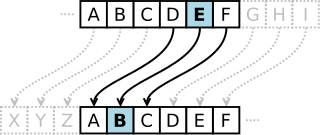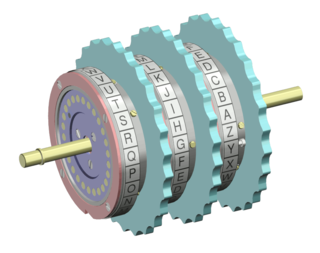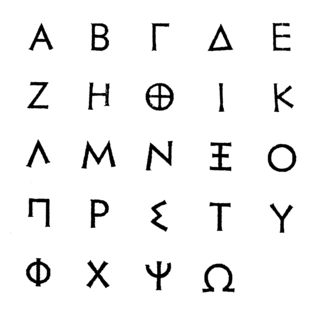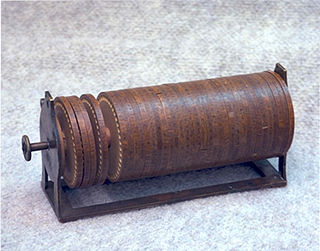Related Research Articles

In cryptography, a cipher is an algorithm for performing encryption or decryption—a series of well-defined steps that can be followed as a procedure. An alternative, less common term is encipherment. To encipher or encode is to convert information into cipher or code. In common parlance, "cipher" is synonymous with "code", as they are both a set of steps that encrypt a message; however, the concepts are distinct in cryptography, especially classical cryptography.

In cryptography, the one-time pad (OTP) is an encryption technique that cannot be cracked, but requires the use of a single-use pre-shared key that is larger than or equal to the size of the message being sent. In this technique, a plaintext is paired with a random secret key. Then, each bit or character of the plaintext is encrypted by combining it with the corresponding bit or character from the pad using modular addition.
In cryptography, a substitution cipher is a method of encrypting in which units of plaintext are replaced with the ciphertext, in a defined manner, with the help of a key; the "units" may be single letters, pairs of letters, triplets of letters, mixtures of the above, and so forth. The receiver deciphers the text by performing the inverse substitution process to extract the original message.

In cryptography, a Caesar cipher, also known as Caesar's cipher, the shift cipher, Caesar's code, or Caesar shift, is one of the simplest and most widely known encryption techniques. It is a type of substitution cipher in which each letter in the plaintext is replaced by a letter some fixed number of positions down the alphabet. For example, with a left shift of 3, D would be replaced by A, E would become B, and so on. The method is named after Julius Caesar, who used it in his private correspondence.

The Vigenère cipher is a method of encrypting alphabetic text where each letter of the plaintext is encoded with a different Caesar cipher, whose increment is determined by the corresponding letter of another text, the key.

In cryptography, the tabula recta is a square table of alphabets, each row of which is made by shifting the previous one to the left. The term was invented by the German author and monk Johannes Trithemius in 1508, and used in his Trithemius cipher.

In cryptanalysis, frequency analysis is the study of the frequency of letters or groups of letters in a ciphertext. The method is used as an aid to breaking classical ciphers.

The Playfair cipher or Playfair square or Wheatstone–Playfair cipher is a manual symmetric encryption technique and was the first literal digram substitution cipher. The scheme was invented in 1854 by Charles Wheatstone, but bears the name of Lord Playfair for promoting its use.

In cryptography, a rotor machine is an electro-mechanical stream cipher device used for encrypting and decrypting messages. Rotor machines were the cryptographic state-of-the-art for much of the 20th century; they were in widespread use in the 1920s–1970s. The most famous example is the German Enigma machine, the output of which was deciphered by the Allies during World War II, producing intelligence code-named Ultra.

The Polybius square, also known as the Polybius checkerboard, is a device invented by the ancient Greeks Cleoxenus and Democleitus, and made famous by the historian and scholar Polybius. The device is used for fractionating plaintext characters so that they can be represented by a smaller set of symbols, which is useful for telegraphy, steganography, and cryptography. The device was originally used for fire signalling, allowing for the coded transmission of any message, not just a finite number of predetermined options as was the convention before.
In classical cryptography, the bifid cipher is a cipher which combines the Polybius square with transposition, and uses fractionation to achieve diffusion. It was invented around 1901 by Felix Delastelle.

The M-94 was a piece of cryptographic equipment used by the United States Army, consisting of several lettered discs arranged as a cylinder. It was also employed by the US Navy, under the name CSP 488.

In cryptography, the M-209, designated CSP-1500 by the United States Navy is a portable, mechanical cipher machine used by the US military primarily in World War II, though it remained in active use through the Korean War. The M-209 was designed by Swedish cryptographer Boris Hagelin in response to a request for such a portable cipher machine, and was an improvement of an earlier machine, the C-36.

The Jefferson disk, also called the Bazeries cylinder or wheel cypher, was a cipher system commonly attributed to Thomas Jefferson that uses a set of wheels or disks, each with letters of the alphabet arranged around their edge in an order, which is different for each disk and is usually ordered randomly.

In the history of cryptography, the Kryha machine was a device for encryption and decryption, appearing in the early 1920s and used until the 1950s. The machine was the invention of Alexander von Kryha. During the Second World War, Kryha worked as an officer for the German Wehrmacht. There were several versions; the standard Kryha machine weighed around five kilograms, and was totally mechanical. A scaled down pocket version was introduced later on, termed the "Lilliput" model. There was also a more bulky electrical version.
In the history of cryptography, a grille cipher was a technique for encrypting a plaintext by writing it onto a sheet of paper through a pierced sheet. The earliest known description is due to Jacopo Silvestri in 1526. His proposal was for a rectangular stencil allowing single letters, syllables, or words to be written, then later read, through its various apertures. The written fragments of the plaintext could be further disguised by filling the gaps between the fragments with anodyne words or letters. This variant is also an example of steganography, as are many of the grille ciphers.

The Alberti Cipher, created in 1467 by Italian architect Leon Battista Alberti, was one of the first polyalphabetic ciphers. In the opening pages of his treatise De componendis cifris he explained how his conversation with the papal secretary Leonardo Dati about a recently developed movable type printing press led to the development of his cipher wheel.
The Chaocipher is a cipher method invented by John Francis Byrne in 1918 and described in his 1953 autobiographical Silent Years. He believed Chaocipher was simple, yet unbreakable. Byrne stated that the machine he used to encipher his messages could be fitted into a cigar box. He offered cash rewards for anyone who could solve it.

Cryptography, or cryptology, is the practice and study of techniques for secure communication in the presence of adversarial behavior. More generally, cryptography is about constructing and analyzing protocols that prevent third parties or the public from reading private messages. Modern cryptography exists at the intersection of the disciplines of mathematics, computer science, information security, electrical engineering, digital signal processing, physics, and others. Core concepts related to information security are also central to cryptography. Practical applications of cryptography include electronic commerce, chip-based payment cards, digital currencies, computer passwords, and military communications.

Decius Wadsworth was a Colonel in the U.S. Army before and during the War of 1812. He graduated from Yale College in 1785 with Honors. He was a renowned military organizer, engineer and inventor. In 1812, he was selected to be the 1st Chief of Ordnance for the new United States Army Ordnance Department.
References
- 1 2 3 4 5 6 Kruh, Louis (1982). "THE MYSTERY OF COLONEL DECIUS WADSWORTH'S CIPHER DEVICE". Cryptologia . 6 (3). doi:10.1080/0161-118291857037.